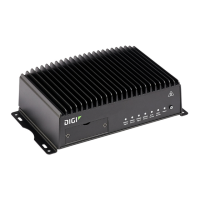Wide Area Networks (WANs)
A Wide Area Network (WAN) provides connectivity to the internet or a remote network. A WAN
configuration consists of the following:
n A physical interface, such as Ethernet or cellular
n Several networking parameters for the WAN, such as IPaddress, mask, and gateway
n Several parameters controlling failover
Using Ethernet interfaces in a WAN
Depending on model type, TransPort devices support several Ethernet interfaces. For example, a
TransPort LR54 device has four Ethernet interfaces, named eth1, eth2, eth3, and eth4. Other models
have fewer Ethernet interfaces, but the naming and numbering of interfaces is similar. You can use
Ethernet interfaces as a WAN when connecting to the Internet, through a device such as a cable
modem, as shown in the example.
By default, the eth1 interface is configured as a WAN with both DHCP and NAT enabled. This means
you should be able to connect to the Internet by connecting the wan/eth1 interface to a device that
already has an internet connection.
The eth2, eth3, and eth4 interfaces are by default configured as a Local Area Network (LAN). If
necessary, you can assign these Ethernet interfaces to a WAN. For more information on Ethernet
interfaces and their configuration, see Ethernet interfaces.
Using cellular interfaces in a WAN
Depending on the model, DigiTransPort devices can support one or two cellular modules, and each
module supports two SIMs. This means that a TransPort device can have either two or four cellular
interfaces:
n cellular1-sim1
n cellular1-sim2
Digi TransPort WR Routers User Guide
56

